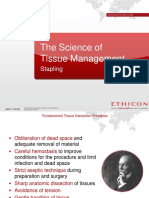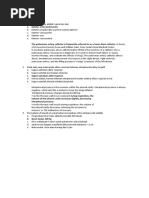0 ratings0% found this document useful (0 votes)
46 viewsSkin-Pathology
Skin-Pathology
Uploaded by
Arfa BaigThe document discusses the anatomy and physiology of skin, describing the epidermis, dermis, and hypodermis layers. It then examines common skin conditions like rashes, dermatitis, eczema, psoriasis, skin cancers, infections, and fungal infections. Pathological features and histological findings are provided for several skin diseases.
Copyright:
© All Rights Reserved
Available Formats
Download as PPTX, PDF, TXT or read online from Scribd
Skin-Pathology
Skin-Pathology
Uploaded by
Arfa Baig0 ratings0% found this document useful (0 votes)
46 views32 pagesThe document discusses the anatomy and physiology of skin, describing the epidermis, dermis, and hypodermis layers. It then examines common skin conditions like rashes, dermatitis, eczema, psoriasis, skin cancers, infections, and fungal infections. Pathological features and histological findings are provided for several skin diseases.
Original Title
9. skin-pathology
Copyright
© © All Rights Reserved
Available Formats
PPTX, PDF, TXT or read online from Scribd
Share this document
Did you find this document useful?
Is this content inappropriate?
The document discusses the anatomy and physiology of skin, describing the epidermis, dermis, and hypodermis layers. It then examines common skin conditions like rashes, dermatitis, eczema, psoriasis, skin cancers, infections, and fungal infections. Pathological features and histological findings are provided for several skin diseases.
Copyright:
© All Rights Reserved
Available Formats
Download as PPTX, PDF, TXT or read online from Scribd
Download as pptx, pdf, or txt
0 ratings0% found this document useful (0 votes)
46 views32 pagesSkin-Pathology
Skin-Pathology
Uploaded by
Arfa BaigThe document discusses the anatomy and physiology of skin, describing the epidermis, dermis, and hypodermis layers. It then examines common skin conditions like rashes, dermatitis, eczema, psoriasis, skin cancers, infections, and fungal infections. Pathological features and histological findings are provided for several skin diseases.
Copyright:
© All Rights Reserved
Available Formats
Download as PPTX, PDF, TXT or read online from Scribd
Download as pptx, pdf, or txt
You are on page 1of 32
Skin pathology
Dr. Saira Jahan
Lecturer
SKIN ANATOMY AND PHYSIOLOGY
SKIN:LARGEST EXTERNAL ORGAN
EPIDERMIS
DERMIS
DERMAL-EPIDERMAL JUNCTION
HYPODERMIS (LOOSE CONNECTIVE TISSUE)
EPIDERMIS
• Thin, avascular layer that regenerates itself every 4 to 6 weeks
• Divided into 5 layers or strata
• Stratum corneum—consists of dead keratinocyte cells; flakes and
sheds; is easily removed during bathing activities and more
efficiently by scrubbing the surface of the skin.
• Stratum granulosum—also contains Langerhans cells in addition to
keratinocytes
• Stratum spinosum—contains keratinocytes and Langerhans cells.
• • Stratum basale or germinativum—single layer of epidermal cells
(keratinocytes); contains melanocytes; can regenerate.
• the stratum lucidum, lies between the stratum corneum and the
stratum granulosum. This packed translucent line of cells is found
only on the palms and soles and is not seen in thin skin.
DERMIS
Matrix that serves to support the epidermis
papillary dermis
reticular dermis
• The papillary dermis is composed of collagen and reticular fibers.
• fingerprint identification
• It contains capillaries for skin nourishment
• pain touch receptors (pacinian corpuscles and Meissner’s
corpuscles)
• The reticular dermis is composed of collagen bundles that anchor
the skin to the subcutaneous tissue.
• Sweat glands, hair follicles, nerves, and blood vessels can be found
in this layer.
Cont..
• The main function of the dermis is to
• provide tensile strength, support, moisture
retention, and blood and oxygen to the skin
protects the underlying muscles, bones, and
organs.
• Sebaceous glands that secrete sebum-
lubricates skin
HYPODERMIS
• The subcutaneous tissue, or hypodermis,
attaches the dermis to underlying structures.
• function is to promote an ongoing blood
supply to the dermis for regeneration. It’s
primarily composed of adipose tissue, which
provides a cushion between skin layers,
muscles, and bones. It promotes skin mobility,
molds body contours, and insulates the body.
SKIN FUNCTIONS
Functions of the skin include:
• protection
• temperature regulation
• metabolism
• sensation
• synthesis
• communication.
The normal range of skin pH is 4 to 6.5 in healthy
people
Skin pathology
• Skin diseases are common and diverse, ranging
from irritating acne to life-threatening
melanoma.
• Either intrinsic to skin, or systemic diseases
involving many tissues, or genetic syndromes
such as neurofibromatosis.
Terms for Macroscopic Lesions
• Excoriation: Trauma breaking the epidermis; a red linear mark (i.e., a deep
scratch)
• Lichenification: Thickened and rough skin; usually the result of repeated
scratching
• Macule: Flat, circumscribed area, (<5 mm), distinguished by color. If >5
mm= a patch.
• Papule: Elevated dome- or flat-topped lesion (< 5 mm). If >5 mm = a
nodule.
• Plaque: Elevated flat-topped lesion, (>5 mm)
• Pustule: Discrete, pus-filled raised lesion.
• Scale: Dry excrescence
• Vesicle: Fluid-filled raised area (<5 mm). If >5 mm = a bulla.
• Blister is common term for both vesicles and bullae
Microscopic Terms
• Acantholysis:
• Acanthosis:
• Hyperkeratosis:
• Papillomatosis:
• Parakeratosis:
• Spongiosis:
Skin Conditions
• Rash: Nearly any change in the skin’s
appearance can be called a rash. Most rashes
are from simple skin irritation; others result from
medical conditions.
• Dermatitis: A general term for inflammation
of the skin. Atopic dermatitis (a type of
eczema) is the most common form.
• Eczema: Skin inflammation (dermatitis)
causing an itchy rash. Most often, it’s due to
an overactive immune system.
• Psoriasis: An autoimmune condition that
can cause a variety of skin rashes. Silver,
scaly plaques on the skin are the most
common form.
.
• Cellulitis: Inflammation of the dermis and
subcutaneous tissues, usually due to an
infection. A red, warm, often painful skin
rash generally results.
• Skin abscess (boil or furuncle): A localized skin
infection creates a collection of pus under the
skin. Some abscesses must be opened and
drained by a doctor in order to be cured
• Melanoma: The most dangerous type of skin
cancer, melanoma results from sun damage
and other causes. A skin biopsy can identify
melanoma.
• Basal cell carcinoma: The most common type
of skin cancer. Basal cell carcinoma is less
dangerous than melanoma because it grows
and spreads more slowly.
• Actinic keratosis: A crusty or scaly bump that
forms on sun-exposed skin. Actinic keratoses
can sometimes progress to cancer.
• Squamous cell carcinoma: A common form of
skin cancer, squamous cell carcinoma may
begin as an ulcer that won’t heal, or an
abnormal growth. It usually develops in sun-
exposed areas.
• Herpes: The herpes viruses
HSV-1 and HSV-2 can cause
periodic blisters or skin
irritation around the lips or
the genitals.
• Hives: Raised, red, itchy
patches on the skin that arise
suddenly. Hives usually result
from an allergic reaction.
• Tinea versicolor: A benign
fungal skin infection creates
pale areas of low
pigmentation on the skin.
• Viral exantham: Many viral infections can cause
a red rash affecting large areas of the skin. This is
especially common in children
INFECTIOUS DERMATOSES
• Bacterial Infections
• Numerous; range from superficial (e.g. impetigo), to deeper
abscesses
• Impetigo: characterized by an accumulation of neutrophils
under stratum corneum a subcorneal pustule.
• one of the most common bacterial infections of the skin
• seen primarily in children
• causative organism: m/c Staph. Aureus; then Strept. pyogenes
• Treatment: Microbiologic culture and antibiotics
Fungal infections of skin
• simple (e.g. Tinea or Candida spp); or life-threatening in
immunosuppressed persons (e.g. Aspergillus spp).
• superficial (e.g. stratum corneum, hair, and nails); deep; or
systemic (hematogenous spread in immunocompromised
pts)
• Histologic appearance:
• Superficial infections neutrophilic infiltrate in the
epidermis.
• Deep infections greater tissue damage; a granulomatous
response
• Periodic acid-Schiff (PAS) and Gomori methenamine silver
stains can be helpful in identifying the fungal organisms
Verrucae (Warts)
• common lesions of children and adolescents.
• caused by human papillomavirus (HPV)
• self-limited, most often regressing spontaneously within 6
months to 2 years.
• most warts are caused by low-risk HPV subtypes (6 and 11)
that lack transforming potential.
• Morphology:
• Verruca vulgaris, the most common type of wart, is found
most frequently on the hands, particularly on the dorsal
surfaces and periungual (around fingernail or toenail)
areas, where it appears as a gray-white to tan, flat to
convex, 0.1- to 1-cm papule with a rough, pebble-like
surface.
• Verruca plana, or flat wart, is common on the
face or dorsal surfaces of the hands; are flat,
smooth, tan macules.
• Verruca plantaris and verruca palmaris occur on
the soles and palms, respectively. These rough,
scaly lesions may reach 1 to 2 cm in diameter
• Condyloma acuminatum (venereal wart) occurs
on the male and female genitalia, urethra, and
perianal areas
Verrucae (Warts)
You might also like
- Detailed Lesson Plan Respiratory SystemDocument7 pagesDetailed Lesson Plan Respiratory Systemjane92% (13)
- Cattle Handling Booklet 2Document43 pagesCattle Handling Booklet 2thechickendidwhatNo ratings yet
- Extravasation Guidance PDFDocument24 pagesExtravasation Guidance PDFAdiAri RosiuNo ratings yet
- 339 MPHEL729 NorthBristolJDFINAL PAEDIATRICANDPERINATALPATHOLOGIST PDFDocument24 pages339 MPHEL729 NorthBristolJDFINAL PAEDIATRICANDPERINATALPATHOLOGIST PDFMD Luthfy LubisNo ratings yet
- CP Headandneck Lip Oralcavity 17protocol 4001Document22 pagesCP Headandneck Lip Oralcavity 17protocol 4001Prashant Jani100% (1)
- History and Physical Report SampleDocument2 pagesHistory and Physical Report SampleloisebadNo ratings yet
- Taiji Qigong 18 MovementsDocument5 pagesTaiji Qigong 18 MovementsMin Than Min Aung100% (2)
- The Skin As An Organ at CBCDocument45 pagesThe Skin As An Organ at CBCEmmanuel DanielsNo ratings yet
- Dermatologist-Level Classification of Skin Cancer With Deep Neural NetworksDocument11 pagesDermatologist-Level Classification of Skin Cancer With Deep Neural NetworksPaulo Lima CamposNo ratings yet
- What's New in Skin Cancer TreatmentDocument56 pagesWhat's New in Skin Cancer TreatmentNational Press Foundation100% (1)
- Skin Cancer Malignancy Classification With Transfer LearningDocument80 pagesSkin Cancer Malignancy Classification With Transfer LearningIlyasse Chemlal100% (1)
- Basic Surgical SkillDocument19 pagesBasic Surgical Skillshadhana sivakumarNo ratings yet
- Skin Cancer Classification Using Convolutional Neural NetworksDocument8 pagesSkin Cancer Classification Using Convolutional Neural NetworksNirmalendu KumarNo ratings yet
- Virtual SurgeryDocument22 pagesVirtual SurgeryMounika Surapaneni100% (1)
- Skin Cancer Detection Using Convolutional Neural Network: Guide Name: Mrs. K .VeenaDocument15 pagesSkin Cancer Detection Using Convolutional Neural Network: Guide Name: Mrs. K .VeenaJaywanth Singh RathoreNo ratings yet
- Skin Cancer!Document8 pagesSkin Cancer!HudiansyahNo ratings yet
- Oral Tumours: DR B M KalyanyamaDocument216 pagesOral Tumours: DR B M Kalyanyamafredrick damianNo ratings yet
- Oral LymphangiomaDocument8 pagesOral LymphangiomasevattapillaiNo ratings yet
- Proceeding 2018 PDFDocument312 pagesProceeding 2018 PDFashish gaurNo ratings yet
- ScabiesDocument15 pagesScabiesAlni Diniaty100% (2)
- Current Wound Healing Procedures and Potential CareDocument30 pagesCurrent Wound Healing Procedures and Potential CarebagasNo ratings yet
- Actinic KeratosisDocument19 pagesActinic KeratosisDajour CollinsNo ratings yet
- Non Melanoma Skin CancerDocument66 pagesNon Melanoma Skin CancerSalmanArif0% (1)
- Skin TumorsDocument56 pagesSkin TumorsAriba Asif100% (1)
- Rekonstruksi SCC Dengan Flap Lateral ForeheadDocument7 pagesRekonstruksi SCC Dengan Flap Lateral Foreheadmichaeljt_md6463No ratings yet
- Microtia Recon Slides 0410Document31 pagesMicrotia Recon Slides 0410Josue Salinas SantosNo ratings yet
- Skin and Its Applied AnatomyDocument56 pagesSkin and Its Applied AnatomyShailesh PatilNo ratings yet
- Overview of Agfa DICOM HL7 Conformance Statements and IHE Integration Statements PDFDocument20 pagesOverview of Agfa DICOM HL7 Conformance Statements and IHE Integration Statements PDFCarinaVillasantiNo ratings yet
- Sarcomas of The Head and Neck: Dr. DarwitoDocument60 pagesSarcomas of The Head and Neck: Dr. DarwitolaurasheerNo ratings yet
- Rhytidectomy: Jaishree Palanisamy Pgy2 Mclaren OaklandDocument73 pagesRhytidectomy: Jaishree Palanisamy Pgy2 Mclaren OaklandTYNo ratings yet
- Ovarian TumoursDocument41 pagesOvarian TumoursVlad RazvanNo ratings yet
- Clinico-Epidemiological Study of Dermatophytosis in Teaching Hospital of North KarnatakaDocument4 pagesClinico-Epidemiological Study of Dermatophytosis in Teaching Hospital of North KarnatakaAldo NovaNo ratings yet
- Presented By: Charlotte Peck: RhabdomyosarcomaDocument13 pagesPresented By: Charlotte Peck: RhabdomyosarcomaBudhiNo ratings yet
- Actinic Keratosis HandoutDocument1 pageActinic Keratosis HandoutNicco Jake AlegroNo ratings yet
- SoTM StaplingDocument20 pagesSoTM StaplingIndrawan Buleth100% (1)
- A Guide To Clinical Differential Diagnosis PDFDocument41 pagesA Guide To Clinical Differential Diagnosis PDFNisa Nafiah OktavianiNo ratings yet
- Biopsy: Reza Fu Rqon SDocument25 pagesBiopsy: Reza Fu Rqon SNovli ArdiansyahNo ratings yet
- Key StoneDocument59 pagesKey StoneJannat JeebaNo ratings yet
- Flap Basics I Rotation and Transposition FlapsDocument9 pagesFlap Basics I Rotation and Transposition FlapsariskaNo ratings yet
- Skin - Grafts by Madhuri GoreDocument112 pagesSkin - Grafts by Madhuri GoreAnonymous 8hVpaQdCtr100% (1)
- Wound Management and Dressing SelectionDocument6 pagesWound Management and Dressing SelectionV15CERA FK UNAND100% (1)
- About Skin Cancer Useful InformationDocument40 pagesAbout Skin Cancer Useful Informationdianp88No ratings yet
- 1998 10 Principles of Tumor BiopsyDocument7 pages1998 10 Principles of Tumor BiopsyJuan MiguelNo ratings yet
- Cervicofacial LymphangiomasDocument11 pagesCervicofacial LymphangiomasCharmila Sari100% (1)
- Auric Recon Slides 070516Document92 pagesAuric Recon Slides 070516Yudhistira AdeNo ratings yet
- Early Clinical Exposure: Dr. Varun Sisodia Secretary MEU KDMCHRCDocument19 pagesEarly Clinical Exposure: Dr. Varun Sisodia Secretary MEU KDMCHRCFrank NobodNo ratings yet
- Descending Necrotizing MediastinitisDocument21 pagesDescending Necrotizing MediastinitisLaksmi Dewi SaputriNo ratings yet
- Silver Sulfadiazine For Treatment of Burns and Wounds PDFDocument7 pagesSilver Sulfadiazine For Treatment of Burns and Wounds PDFprakas.rao39695No ratings yet
- Blood Supply of Head & NeckDocument43 pagesBlood Supply of Head & NeckPankaj JindalNo ratings yet
- TW Whitepaper Guide To Evaluating Mlops Platforms 2021Document33 pagesTW Whitepaper Guide To Evaluating Mlops Platforms 2021Renata CastanhaNo ratings yet
- Quantec Aamd PDFDocument41 pagesQuantec Aamd PDFNika TopuriaNo ratings yet
- IDC Futurescapes Predictions 2018 PDFDocument25 pagesIDC Futurescapes Predictions 2018 PDFVasilis KoutsoubasNo ratings yet
- Hernia: DR - Surender Singh DhankharDocument36 pagesHernia: DR - Surender Singh DhankharBharat BhushanNo ratings yet
- Augmentasi Mammae & MastopexyDocument52 pagesAugmentasi Mammae & MastopexySitha ChristineNo ratings yet
- Breast Reconstruction After Mastectomy For Breast Tumor: About 24 CasesDocument6 pagesBreast Reconstruction After Mastectomy For Breast Tumor: About 24 CasesIJAR JOURNALNo ratings yet
- Journal Homepage: - : IntroductionDocument22 pagesJournal Homepage: - : IntroductionIJAR JOURNALNo ratings yet
- 10.1007@978 3 319 62539 3Document402 pages10.1007@978 3 319 62539 3vernadskyi100% (1)
- Robotic SurgeryDocument20 pagesRobotic SurgerychhabraashishNo ratings yet
- Principles and Practice of Percutaneous Tracheostomy (PDFDrive)Document181 pagesPrinciples and Practice of Percutaneous Tracheostomy (PDFDrive)Tan Zhen YiNo ratings yet
- Sample Size Calculation: Basic Principles: Review ArticleDocument5 pagesSample Size Calculation: Basic Principles: Review Articlenmmathew mathewNo ratings yet
- Skin Cancer TBL 2 2f3Document19 pagesSkin Cancer TBL 2 2f3api-356476029No ratings yet
- Diagnosis and Treatment of MelanomaDocument14 pagesDiagnosis and Treatment of MelanomaAnonymous Af24L7No ratings yet
- StainingDocument29 pagesStainingarebu gashawNo ratings yet
- Dermatoscopy and Skin Cancer, updated edition: A handbook for hunters of skin cancer and melanomaFrom EverandDermatoscopy and Skin Cancer, updated edition: A handbook for hunters of skin cancer and melanomaNo ratings yet
- Breathing and Stretching - Docx - Breathing and Stretching TechniquesDocument5 pagesBreathing and Stretching - Docx - Breathing and Stretching Techniquesfabz77100% (3)
- Soal CBT Anestesi Pembahasan 18109 - 1-1Document16 pagesSoal CBT Anestesi Pembahasan 18109 - 1-1Auliya Andi100% (1)
- English-3 4th-Quarter Answer-Sheets MCanaria Final-3Document18 pagesEnglish-3 4th-Quarter Answer-Sheets MCanaria Final-3LeviNo ratings yet
- ABDOMEN: Posterior Abdominal Region IDocument19 pagesABDOMEN: Posterior Abdominal Region IElijah JeusNo ratings yet
- Para Notes - SummaryDocument4 pagesPara Notes - SummaryReg LagartejaNo ratings yet
- Williams-Pathology of The Ferret POLA 2010 Ferret MinkDocument45 pagesWilliams-Pathology of The Ferret POLA 2010 Ferret MinkRachel AutranNo ratings yet
- Dog Breeds 202145568Document12 pagesDog Breeds 202145568Arch. ZionNo ratings yet
- Circuitary and Cannulation TechniquesDocument125 pagesCircuitary and Cannulation Techniquesshivalingam20No ratings yet
- Anatomy and Physiology Unit 10 Test Review KEYDocument7 pagesAnatomy and Physiology Unit 10 Test Review KEYsenjicsNo ratings yet
- SHP Homeopathy As A Treatment For HIV and Aids Session 1Document14 pagesSHP Homeopathy As A Treatment For HIV and Aids Session 1lghmshari100% (1)
- AP 10th Class Biology Study MaterialDocument212 pagesAP 10th Class Biology Study MaterialPreeti ThakurNo ratings yet
- Scientia MARDI - Vol 004 - February 2015Document12 pagesScientia MARDI - Vol 004 - February 2015MARDI Scribd75% (4)
- Lecture On The Histology of Peripheral Nerve and Ganglia by Dr. RoomiDocument15 pagesLecture On The Histology of Peripheral Nerve and Ganglia by Dr. RoomiMudassar RoomiNo ratings yet
- Poultry Disease Early Detection Methods Using DeepDocument12 pagesPoultry Disease Early Detection Methods Using DeepanggikaNo ratings yet
- Stages of LaborDocument43 pagesStages of LaborMASII100% (1)
- ABO Ideal Photos-RadiographsDocument23 pagesABO Ideal Photos-Radiographscecilled_08No ratings yet
- Evolution of NeonatologyDocument17 pagesEvolution of NeonatologyClaudia KosztelnikNo ratings yet
- Nursing Board Exam Q&ADocument81 pagesNursing Board Exam Q&Airene800086% (7)
- Form 5: Chapter 12 Coordination and ResponseDocument8 pagesForm 5: Chapter 12 Coordination and Responseapi-3841154No ratings yet
- Speech Night OwlDocument5 pagesSpeech Night OwlAmin SubriNo ratings yet
- Final Copy of Newborn CareDocument47 pagesFinal Copy of Newborn CareSheena Claire100% (1)
- Icu CPDocument5 pagesIcu CPJezner GamosNo ratings yet
- Stories of Children Who Have Been Raised by Wild AnimalsDocument5 pagesStories of Children Who Have Been Raised by Wild AnimalsScribdTranslationsNo ratings yet
- AnfibiosDocument31 pagesAnfibiosMary M. Gonzalez100% (1)
- Synthesis Essay Revision - Remi Lin 411110208Document4 pagesSynthesis Essay Revision - Remi Lin 411110208vivian930424No ratings yet
- Siti Aisyah, Uterine ProlapseDocument18 pagesSiti Aisyah, Uterine ProlapseHerti MarniNo ratings yet

























































































